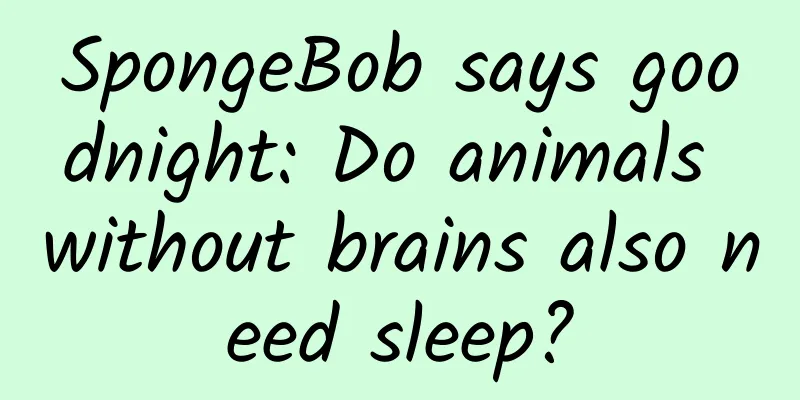SpongeBob says goodnight: Do animals without brains also need sleep?

|
I wake up to sleep while others sleep to wake up. Written by | Kestrel In the giant brown kelp forests off the coast of Southern California, there is a creature called a puffball sponge (Tethya californiana) that looks like a miniature pumpkin. No one paid much attention to it until 2017, when William Joiner, a neurobiologist at the University of California, San Diego (UCSD), decided to study it: whether they sleep. Figure 1. Puffball Sponge (Tethya californiana) | By Ed Bierman - Flickr: Puffball Sponge, Tethya aurantia, CC BY 2.0, https://commons.wikimedia.org/w/index.php?curid=18999005 At first glance, you might think this question is stupid. How can you sleep without a brain? But in recent years, some studies on nematodes, jellyfish and hydras have challenged the traditional view that "sleep is a privilege exclusive to animals with brains." David Raizen, a neuroscientist at the University of Pennsylvania, said: "Now, finding animals that have no nerve cells but can sleep is the forefront of the sleep field." Sponges are one of the earliest animal groups on Earth and are the best candidates to break the traditional view. Catching a dozing sponge may directly overturn the academic definition of sleep and change our understanding of the purpose of sleep. Scientists generally define sleep as a "state of temporary loss of consciousness" that is dominated by the brain and is good for the brain. Therefore, studying the "sleep" of brainless animals is controversial. Many people believe that the unresponsive state seen in jellyfish and hydras can only be called a "sleep-like state" and not "sleep." They do not believe that these animals sleep, at least not like humans. Obviously, this involves how to define sleep. Lower animals certainly cannot show the same sleep characteristics as us, but if some of the molecular mechanisms related to sleep are somewhat conserved from jellyfish to humans, we can call the unresponsive state of jellyfish "protosleep." "Protosleep" means that it is related to "sleep" in evolution. Figure 2. Sleep characteristics of representative animals from various groups [1] The academic community generally believes that sleep emerged with the evolution of vertebrates. However, other scientists hold different views, believing that sleep existed after the most primitive animals appeared. "Every living thing will sleep," said Paul Shaw, a neuroscientist at the University of Washington. The earliest biological forms evolved from no response to being able to respond to the external environment, and sleep is a return to the "default state." Shaw believes: "We did not evolve the function of sleep, but evolved the function of wakefulness." ——Wait! Have you heard this sentence before? Does it remind you of the conversation between the male protagonist and the old man in the basement when he was looking for a powerful hypnotic in "Inception"? "They come to sleep every day?" "No. They come here to wake up. The dream world has become their real world." Figure 3. Relevant scenes from Inception This view may seem a bit mysterious, but the more interesting part is its hidden premise: Are there really animals without the so-called "awakening function"? Is the reason why plants are plants and fungi are fungi related to their lack of evolution of the "awakening function"? If this is true, the sleep behavior of humans, rodents and other vertebrates is a highly evolved form of sleep that adapts to the needs of the body and lifestyle. To study the nature of sleep behavior, it is probably difficult to get a glimpse of it directly from these higher animals. We still have to look for the basic form of sleep in simpler and more primitive animal groups. Therefore, researchers have found that sleep benefits more than just the brain, from fruit flies and nematodes to sponges, and from sponges to placozoans [2]. They have found that sleep benefits muscles, the immune system, and the intestines. This work may shift the focus of the sleep field from the effects of sleep on complex cognitive processes to its effects on basic cellular activities. In the early days, the definition of sleep came from its "behavior changes" in people: lying down, closing your eyes, not moving, and losing awareness of the outside world - this is sleep. The consequences of not sleeping are also obvious, such as being unable to concentrate in meetings and even falling asleep while driving. In the 1950s and 1960s, researchers gradually accepted polysomnography, a technique that simultaneously measures brain activity, eye movements, and muscle tone, creating a gold standard for defining sleep. Neuroscientists placed electrodes on the surface of the scalp to record brain electrical activity, dividing the human sleep process into two stages: rapid eye movement (REM) sleep and non-REM sleep. The former is the stage where dreams are generally produced, while the latter is characterized by synchronized slow waves of EEG. Figure 4. Human polysomnography (schematic) [3] Previous behavioral and physiological experiments have long shown that the sleep characteristics of animals are diverse. Cows and other large herbivores sleep standing up; dolphins can sleep while swimming, and some birds can sleep while flying, allowing half of the brain to nap while the other half continues to work. Bats sleep about 20 hours a day, while wild elephants only sleep 2 hours. Meanwhile, most animals studied using electrophysiological techniques have at least two stages of sleep, although the details may vary from animal to animal. Octopuses change color when they sleep, and it seems that their sleep is also divided into stages. At the turn of the century, evidence of sleep in animals other than mammals began to emerge, prompting scientists to start digging for species further down the evolutionary tree. Naturally, they first had to figure out how to define sleep in these simpler species. Jellyfish look the same when they’re asleep as when they’re awake, but you can’t stick electrodes on them. Researchers had to find out when and where these species rest, figure out which behaviors they stop when they sleep, sometimes poke them to make sure they don’t respond, and see how sleep deprivation affects them. In 2017, Caltech graduate student Michael Abrams and two classmates conducted an experiment using Cassiopea jellyfish. Cassiopea jellyfish like to stay on the seabed, with their tentacles pulsating and pointing upwards so that the symbiotic photosynthetic microorganisms can get more sunlight. They found that the frequency of the tentacles' pulsations dropped from 60 times per minute to 39 times per minute at night. In order to further verify whether these jellyfish were really "asleep", they built a fake "seabed" and pulled away the mat under the jellyfish during the experiment to see how the jellyfish would react when they found that the seabed had lowered. As a result, the jellyfish looked "groggy" at night and swam to the new seabed more slowly than during the day. They also created water currents to harass the jellyfish, and as a result, these jellyfish were not very active the next day, as if they had insomnia. Finally, melatonin (a hormone that regulates the biological clock) was given to the jellyfish, and the frequency of the tentacle beats dropped to the nighttime level, just like when people take melatonin to help them sleep. Note that jellyfish do not have a real brain, they only have a circle of nerve cell clusters distributed on the edge of the bell-shaped part. Figure 5. The distribution of neurons in jellyfish (left, stained dark) and a schematic diagram of the nervous system (right) [4]. Later, researchers caught another animal that has no brain but can take naps: Hydra vulgaris, which belongs to the same phylum as jellyfish, Cnidaria. Taichi Itoh, a biological clock expert at Kyushu University in Japan, and his colleagues placed Hydra vulgaris in a 12-hour light-dark cycle in the laboratory and filmed the twisting of their tentacles. They found that the tentacles twisted more slowly when the light was dim [5]. The above studies on jellyfish and hydra followed the old standards and regarded "reduced responsiveness" as a manifestation of sleep. In addition, some scientists have begun to focus on the molecular level and look for genes that play a role in the signaling pathways that promote sleep. For example, in 2020, Itoh's team reported that the activity of more than 200 genes in "sleep-deprived" hydra changed; some of these genes also play a role in the sleep of fruit flies [6]. “We are moving more and more from a behavioral and physiological perspective to a cellular and molecular perspective on sleep,” said Philippe Mourrain, a neurobiologist at Stanford University. “The broader our definition of sleep, the closer we are to a comprehensive understanding of its function.” For animals with brains, sleep naturally has benefits for the brain, such as consolidating memories, allowing cerebrospinal fluid to flush out toxic metabolic waste, and perhaps even helping to maintain synaptic plasticity in the brain [7]. But these reasons don’t make sense for animals without brains. “Since sleep characteristics are so conserved, it may have a more fundamental role, namely maintaining basic physiological processes,” commented Amita Sehgal, a neuroscientist at the University of Pennsylvania. Some clues from brainless animals suggest that sleep is designed for energy budget and metabolism. Raizen's team found that Caenorhabditis elegans only naps when metabolic demand is high; its larvae are in a "droopy" state similar to sleep during the one or two hours of molting. When high temperatures or ultraviolet radiation cause stress responses in nematodes, they will also "droop." The team also found that a protein called salt-inducible kinase 3 is directly related to sleep and metabolism. This protein can regulate sleep in mammals, and in nematodes, it can mobilize fat reserves and improve the nematode's energy metabolism level [8]. In hydra, Itoh's team also found a gene that affects both metabolism and sleep. Sleep deprivation studies have also shown that sleep affects metabolism. Sehgal discovered a mutant fruit fly with reduced sleep, whose nitrogen metabolism was abnormal, resulting in abnormal protein turnover (synthesis and degradation) and nitrogenous waste disposal, which ultimately led to the accumulation of polyamines in the body and caused DNA and RNA damage. In other words, when we are deprived of sleep, it is not just the brain that suffers. For example, in 2020, Harvard Medical School biologist Dragana Rogulja published a study in the journal Cell, stating that sleep deprivation seems to affect the intestines of fruit flies and mice, leading to the accumulation of reactive oxygen species (ROS), damaging cellular DNA and other intracellular substances, and causing cell death. Rogulja speculated that the intestine, as one of the earliest organs evolved in multicellular animals, may be the original beneficiary of sleep; and as animals evolved more and more complex, sleep developed so many new functions. To understand the nature of sleep, Raizen decided to study more primitive species that don't even have a gut. He decided to study placozoans, a group of transparent, flat, sesame-sized organisms that have only two layers of cells and cilia on both sides. Placozoans have no nerve cells, and their cells communicate through chemical signals to coordinate the movement of their cilia. It can be said that, except for some parasites, placozoans are the simplest animals on Earth. Figure 4. Placozoa, as the name suggests, are shaped like flat plates, generally about one millimeter in diameter and only about 25 microns thick. They move like an enlarged version of an amoeba. They have no tissue or organ layers, and their bodies have no obvious symmetry. They only have six types of thousands of cells in total forming a three-layer structure. [9-10] Placozoa crawl around on the rocks at the tide level, stopping to feed when they come across microalgae. Bernd Schierwater, an evolutionary biologist at the University of Veterinary Medicine Hannover, believes that the placozoa's slowing behavior represents the first step in the evolution of sleep rhythms, allowing them to recharge for the next feeding cycle. For placozoa, which lack high-power neurons, this may be enough. Before discovering that hydras and jellyfish sleep, neuroscientist Carolyn Smith also thought the idea of placozoans sleeping was silly. But now, she even suspects that the behavior of these placozoans spinning in circles is also a form of sleep. Placozoans will shrink when exposed to ultraviolet light, and using this to shine ultraviolet light can determine whether they are in a "sleeping" and unresponsive state. However, simple animals may not be easy to keep alive. Smith provided some flat disc animal samples to Raizen, but they were too picky and all died. Joiner encountered similar problems when studying puffball sponges. He worked with Greg Rouse, a biologist at the Scripps Institution of Oceanography, to take good care of these sponges, fetching some seawater for them at the beach on his way to work every day, because puffball sponges need to eat microorganisms in the seawater. They fixed the water tank for the sponges to the incubator, controlled the light and temperature, and finally, they added a magnetic stirrer to the water tank, which was finally able to keep the sponges in a relatively healthy state. Joiner and Rouse set up a digital camera above the tank to record the slight contraction of the sponge's body when filtering food. The results showed that the sponges in the tank contracted about every 3 hours. This discovery means that the researchers have finally found a reliable behavioral feature that can be used to monitor sponge sleep changes. Sandie Degnan and Bernard Degnan, marine biologists at the University of Queensland, St. Lucia, Australia, studied another type of sponge: Amphimedon queenslandica, which is distributed in the Great Barrier Reef. This is the first sponge to have its entire genome sequenced. It has several genes whose homologous expression levels in other species oscillate in a 24-hour cycle [11]. Now, Degnan's team has observed that the contraction of this sponge may have a circadian rhythm, and some sponges do not pump water even during the day, as if they were catching up on sleep after working a night shift, which is very close to sleep [1]. They believe that the sponge's periodic rest may be to reorganize and rejuvenate its own cells. After all, they pump out about 1,000 times their own volume of water in a day. Next, the researchers plan to use glutamate (an excitatory neurotransmitter in higher animals) or other drugs to make the sponges pump water endlessly for days or weeks to see if their health is affected. If so, it would show that multicellular animals need such cyclical behavior to allow time for tissue repair and regeneration. If cells throughout the body benefit from sleep, it's reasonable to assume that cells throughout the body have a say in when to sleep. In this way, understanding the underlying mechanisms of sleep control may point to new avenues for treating sleep disorders, which affect 60 million people in the United States alone. Ketema Paul, a neurobiologist at the University of California, Los Angeles (UCLA), studies a protein called Bmal1. Bmal1 is ubiquitous, regulates gene expression, and can keep sleep-deprived mice awake. Until now, researchers believed that this was the purpose of the brain’s production of Bmal1. But Paul’s team found that the Bmal1 in sleep-deprived mice is actually produced by the muscles[12]! He speculates that this protein may be part of a signaling pathway that allows the brain to couple muscle fatigue with the sleepiness generated by the brain. Other studies using mice have shown that the digestive tract, pancreas and adipose tissue can produce signaling molecules that affect the onset and end of sleep. These signaling molecules are called neurohormones. Obviously, understanding the feedback signaling pathways of these organs to the brain may find new drugs for treating sleep disorders. New drugs no longer only act on the brain, but can target other parts. Paul believes that in the future there may be a Bmal1 drug that targets muscles to counteract the adverse effects of staying up all night. Fifteen years ago, when Mourrain first began studying fish sleep, many people believed that fish did not sleep. It was not until two years ago that his team developed polysomnography for fish and used the technology to discover that fish—similar to humans—also experience quiet and active sleep states.[13] “This was a turning point in our field,” Mourrain said. “It convinced skeptics that fish are comparable to mammals in the field of sleep and are also good animal models.” Now, Mourrain's team is developing a new experimental method to observe how information is transmitted cell by cell. They chose a small fish (Danionella translucida) the size of a thumbnail, and used fluorescent or other types of markers to track the fish brain and body to observe how different types of cells control sleep over time and benefit from it. Figure 7: This small transparent fish (Danionella translucida) is only about 1 cm long [1]. So, after fish, could puffball sponges be the next animal to disprove the skeptics? Probably not so fast—they can’t stay healthy long enough in a lab setting to produce reliable experimental data, and the research team has been struggling to build the device. Then, the coronavirus pandemic hit, and the experiments had to be stopped, and now there aren’t even enough people to restart them. Could the aforementioned hydra with its wiggling tentacles be a candidate? We'll have to wait and see. References [1] Pennisi, E. (2021). The simplest of slumbers. Science, 374(6567), 526-529. https://doi.org/10.1126/science.acx9444 [2] Anafi, RC, Kayser, MS, & Raizen, DM (2019). Exploring phylogeny to find the function of sleep. Nat Rev Neurosci, 20(2), 109-116. https://doi.org/10.1038/s41583-018-0098-9 [3] Liu, D., & Dan, Y. (2019). A Motor Theory of Sleep-Wake Control: Arousal-Action Circuit. Annu Rev Neurosci, 42, 27-46. https://doi.org/10.1146/annurev-neuro-080317-061813 [4] Weissbourd, B., Momose, T., Nair, A., Kennedy, A., Hunt, B., & Anderson, DJ (2021). A genetically tractable jellyfish model for systems and evolutionary neuroscience. Cell, 184(24), 5854-5868 e5820. https://doi.org/10.1016/j.cell.2021.10.021 [5] Kanaya, HJ, Park, S., Kim, JH, Kusumi, J., Krenenou, S., Sawatari, E., Sato, A., Lee, J., Bang, H., Kobayakawa, Y., Lim, C., & Itoh, TQ (2020). A sleep-like state in Hydra unravels conserved sleep mechanisms during the evolutionary development of the central nervous system. Sci Adv, 6(41). https://doi.org/10.1126/sciadv.abb9415 [6] Artiushin, G., & Sehgal, A. (2017). The Drosophila circuitry of sleep-wake regulation. Curr Opin Neurobiol, 44, 243-250. https://doi.org/10.1016/j.conb.2017.03.004 [7] Lewis, LD (2021). The interconnected causes and consequences of sleep in the brain. Science, 374(6567), 564-568. https://doi.org/10.1126/science.abi8375 [8] Grubbs JJ, Lopes LE, van der Linden AM, Raizen DM (2020) A salt-induced kinase is required for the metabolic regulation of sleep. PLOS Biology 18(4): e3000220. https://doi.org/10.1371/journal.pbio.3000220 [9] Eitel M, Osigus HJ, DeSalle R, Schierwater B (2013) Global Diversity of the Placozoa. PLoS ONE 8(4): e57131 [10] https://elifesciences.org/digests/36278/the-simplest-animals-have-a-complicated-past [11] Jindrich, Katia, Roper, Kathrein E., Lemon, Sussan, Degnan, Bernard M., Reitzel, Adam M., and Degnan, Sandie M. (2017). Origin of the animal circadian clock: diurnal and light-entrained gene expression in the sponge Amphimedon queenslandica. Frontiers in Marine Science 4 (OCT) 327. https://doi.org/10.3389/fmars.2017.00327 [12] Ehlen, JC, Brager, AJ, Baggs, J., Pinckney, L., Gray, CL, DeBruyne, JP, Esser, KA, Takahashi, JS, & Paul, KN (2017). Bmal1 function in skeletal muscle regulates sleep. Elife, 6. https://doi.org/10.7554/eLife.26557 [13] Leung, LC, Wang, GX, Madelaine, R., Skariah, G., Kawakami, K., Deisseroth, K., Urban, AE, & Mourrain, P. (2019). Neural signatures of sleep in zebrafish. Nature, 571(7764), 198-204. https://doi.org/10.1038/s41586-019-1336-7 Source: Fanpu |
<<: Average age: 33! They spent 10 years to build a super "purifier" for China's space station
>>: If I cut my finger, can I disinfect it by sucking on it in my mouth?
Recommend
Don’t blame the router for factors that affect Wi-Fi signal coverage
In the test of wireless routers, we know that the...
How much does it cost to customize a watch mini program in Handan?
How much does it cost to customize the Handan wat...
The first "miracle drug for myopia" in China has been approved for sale! Please note that it can't be used just because you are myopic
The latest information on the official website of...
How to plan high-conversion activities in live broadcast rooms?
Today, let’s discuss how to conduct private domai...
Be careful, the cadmium content exceeds the standard by 7310 times, there are so many tricks in silver jewelry!
Have you ever felt or heard of something like thi...
From the "May Day" routine of operation, let's see how to "take advantage of the festival"
Not long after Qingming Festival, May Day comes. ...
Not only from north to south, but also from east to west, in a circle... "Where do birds go?"
As the northern hemisphere enters winter, a spect...
Screenshots and introductions of Apple Watch built-in apps and third-party apps
Apple Watch excels at quick check of information ...
What is the specific situation of not giving homework to students other than junior high school and senior high school students? Why?
On March 12, the Beijing Education System Epidemi...
Are fluffy powder and wash-free spray the magic weapon to save oily-haired girls? Doctor: Don't use them, you'll go bald
"I found that the only thing that I have not...
Touch Technology Cocos Store officially introduces Founder fonts
The practicality and convenience of the "one...
Why do my joints hurt when it gets cold? Is it because I don't wear long underwear?
As the saying goes The legs age first Many elderl...
Overall planning scheme for Tik Tok short video operations!
Tik Tok short videos are very popular, and both i...
A 10-year-old boy got meningitis after playing with a snail? How to deal with this kind of snail?
Today, a news report about a 10-year-old boy cont...
Soul advertising, Soul advertising account opening, Soul advertising charges
This article outlines: 1. How to place Soul ads 2...









